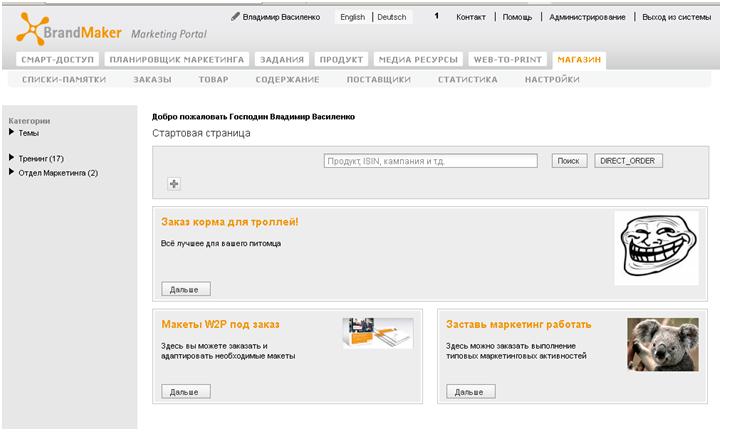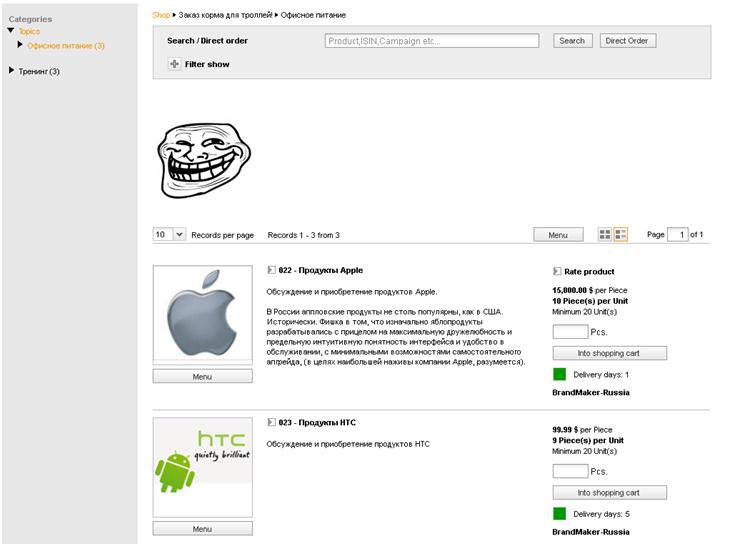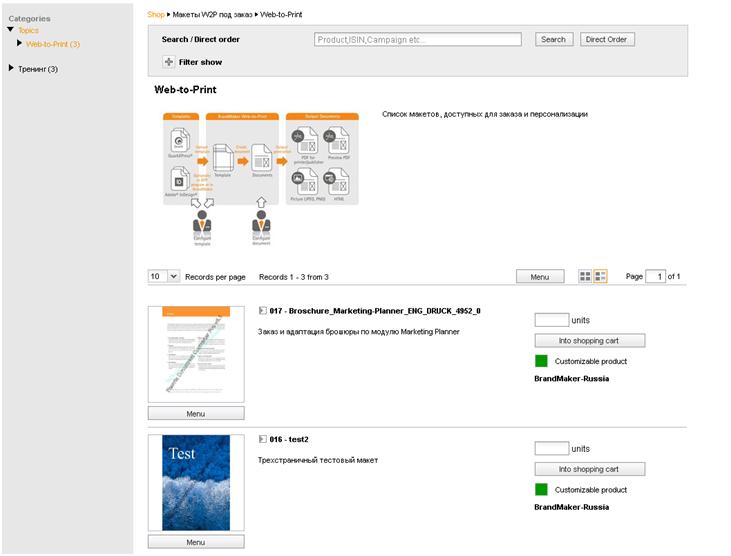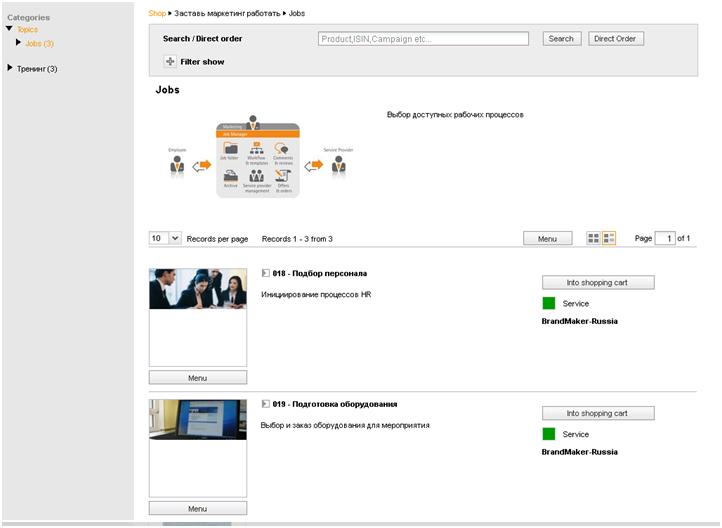Intracorporate "store" and how to use it
Good day, Habr!
In our records, we briefly talked about the key modules of BrandMaker - Media Resources , Scheduler , Web-to-Print, Review Manager , included in the "basic configuration" of the system.
But besides them, there are others that are additionally connected, with a specific set of functions. One of them is the Shop module.

')
The module is very promising, with great potential for use in large companies with a developed branch / dealer network. It is intended for building a system of supplying branches with materials from the center. At the same time, like the whole BrandMaker system, it was created specifically for advertising / marketing departments. This leaves its mark - the module can do what the corresponding modules of universal ERP systems do not.
So, what is the Store module from the user's point of view. A separate tab is selected for it in the system interface, on the start page of which there is a category tree and customizable teasers for quick access to key sections of the store. In this case, specifically to show the versatile use of the module, we created three sections - for objects of different types.

which can be ordered through the Shop - these are ordinary goods - for example, stationery, office equipment or equipment itself, etc. - which are purchased centrally and written off to branches from a single warehouse.

Each product has its own “showcase” with an image of the product and its description. This favorably distinguishes the module from the traditional warehouse programs, where each product is just a line from the nomenclature. In addition, the characteristics of the order are indicated in the product profile - the number of units in a package, the minimum order quantity, stock availability, and the like.

If we talk about processing orders for goods of this type, then the “Store”, of course, is full of competitors - the same SAP, or 1C, or even self-signed programs. But, once again I will note - the advantage of BrandMaker consists in specialization, in accounting for the specifics of the work of marketing divisions. And this is especially noticeable in the example of non-standard types of objects, which are described below.

During the application process in a separate dialog box, you can access the functionality of the Web-to-Print module, make all necessary changes to the layout and attach a print-ready file to the order. From the point of view of managers working with printing in the field and in central offices, this is simply a fairy tale compared to traditional schemes.


When placing such an order, the user automatically initiates a new task in another module of the system - Jobs, for the person in charge assigned to this or that typical process. To do this, he fills out the appropriate brief, if necessary attaching any files to it.

There are also
Thus, the “Store” is a module that allows working with the most diverse types of objects and streamlining the supply of materials from the center to the company's branches. At the same time, it can serve as just a means for placing orders, as well as a means of collecting applications for a particular type of product in order to determine the volume of centralized procurement.
For example, without this system, a manager engaged in the centralized production of printing, in order to estimate the required circulation, must:
1. Send a letter to all affiliates requesting them to reset the application for the required amount of printing and the information necessary for customizing layouts (for example, current phone addresses, etc.)
2. Collect all applications and put them together, determining the total circulation.
3. Based on the information provided by the branches, customize all the layouts taking into account the particularities of the regions (independently or with the assistance of a designer)
4. Collect all materials and send them to the printing house.
With the “Store” module it:
1. Sends a letter to the branches with a request to reset the application for printing and attach to them localized layouts, ready for printing.
2. Waiting for all affiliates to provide information.
3. Sends materials to the printing house.
4. Profit!
In our records, we briefly talked about the key modules of BrandMaker - Media Resources , Scheduler , Web-to-Print, Review Manager , included in the "basic configuration" of the system.
But besides them, there are others that are additionally connected, with a specific set of functions. One of them is the Shop module.

')
The module is very promising, with great potential for use in large companies with a developed branch / dealer network. It is intended for building a system of supplying branches with materials from the center. At the same time, like the whole BrandMaker system, it was created specifically for advertising / marketing departments. This leaves its mark - the module can do what the corresponding modules of universal ERP systems do not.
So, what is the Store module from the user's point of view. A separate tab is selected for it in the system interface, on the start page of which there is a category tree and customizable teasers for quick access to key sections of the store. In this case, specifically to show the versatile use of the module, we created three sections - for objects of different types.

The first type of objects
which can be ordered through the Shop - these are ordinary goods - for example, stationery, office equipment or equipment itself, etc. - which are purchased centrally and written off to branches from a single warehouse.

Each product has its own “showcase” with an image of the product and its description. This favorably distinguishes the module from the traditional warehouse programs, where each product is just a line from the nomenclature. In addition, the characteristics of the order are indicated in the product profile - the number of units in a package, the minimum order quantity, stock availability, and the like.

If we talk about processing orders for goods of this type, then the “Store”, of course, is full of competitors - the same SAP, or 1C, or even self-signed programs. But, once again I will note - the advantage of BrandMaker consists in specialization, in accounting for the specifics of the work of marketing divisions. And this is especially noticeable in the example of non-standard types of objects, which are described below.
Second type
- this is promotional material. The main “trick” in this case is the ability to customize the layout of the leaflet, business card, catalog being ordered right at the time of the order.
During the application process in a separate dialog box, you can access the functionality of the Web-to-Print module, make all necessary changes to the layout and attach a print-ready file to the order. From the point of view of managers working with printing in the field and in central offices, this is simply a fairy tale compared to traditional schemes.

The third type of objects
- these are services. As such objects, you can start standard projects and collect applications for them from departments. For example, sign replacement, layout development, carrying out SMS distribution, providing information on the market for a certain period, etc. In addition, Shop can also be used as a channel for receiving such requests from external users who have access to the system. (For this you can
When placing such an order, the user automatically initiates a new task in another module of the system - Jobs, for the person in charge assigned to this or that typical process. To do this, he fills out the appropriate brief, if necessary attaching any files to it.

There are also
fourth type of objects
These are media objects that are not available for free download from the Media Resources module, but require an access request. The user creates a request to receive this file, and it is processed through the module "Shop". An alternative option is a request to download through the administrator of “Media Resources”, but this is not always convenient.Thus, the “Store” is a module that allows working with the most diverse types of objects and streamlining the supply of materials from the center to the company's branches. At the same time, it can serve as just a means for placing orders, as well as a means of collecting applications for a particular type of product in order to determine the volume of centralized procurement.
For example, without this system, a manager engaged in the centralized production of printing, in order to estimate the required circulation, must:
1. Send a letter to all affiliates requesting them to reset the application for the required amount of printing and the information necessary for customizing layouts (for example, current phone addresses, etc.)
2. Collect all applications and put them together, determining the total circulation.
3. Based on the information provided by the branches, customize all the layouts taking into account the particularities of the regions (independently or with the assistance of a designer)
4. Collect all materials and send them to the printing house.
With the “Store” module it:
1. Sends a letter to the branches with a request to reset the application for printing and attach to them localized layouts, ready for printing.
2. Waiting for all affiliates to provide information.
3. Sends materials to the printing house.
4. Profit!
Source: https://habr.com/ru/post/140685/
All Articles